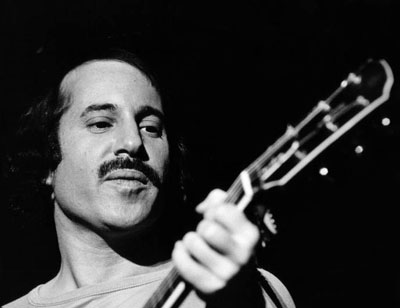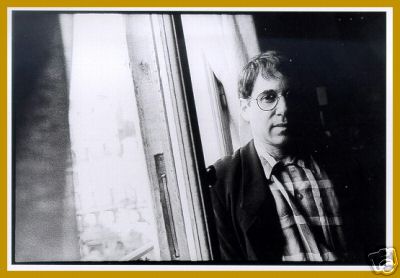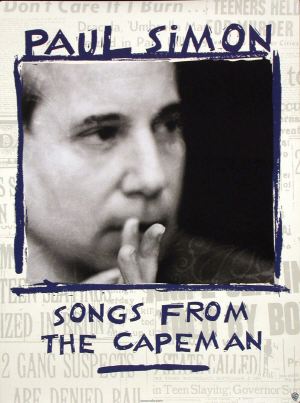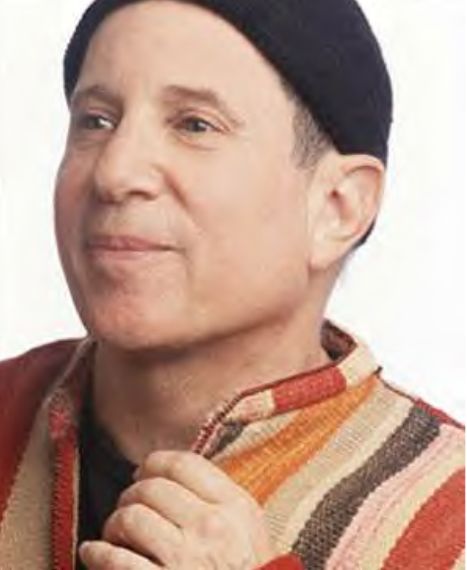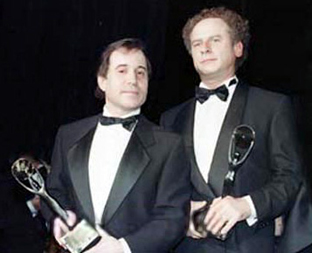
Early Life
Paul Frederic Simon was born on the 13th October 1941 in Newark , New Jersey
to Jewish Hungarian parents Belle and Louis Simon. His childhood was spent
with his parents and his brother Eddie Simon in Kew Gardens Hills, Queens
, New York City. Paul’s musical career began at a young age, as far back
as elementary school in a production of Alice in Wonderland in which he performed
with his close childhood friend Arthur Garfunkel. They later attended Forest
Hills High School together, where their musical tastes were further developed,
and where they wrote their first songs and made their first recordings. The
duo tried to emulate the sounds of 50s doo-wop and rock ‘n’ roll,
in particular the Everly Brothers, and Paul was also inspired by his father
who was a bass player and bandleader in his spare time. Paul and Artie had
their first taste of success as Tom and Jerry with
the single ‘Hey, Schoolgirl’ in 1957, which rose to #49 on the Billboard
charts.
 Tom & Jerry
Tom & Jerry
After graduating from high school Paul attended Queens College , earning a degree in English Literature. He was briefly enrolled at Brooklyn Law School but his passion remained in singing and songwriting. Between 1957 (the year of ‘Hey, Schoolgirl’) and 1964 (the year of his first album, The Paul Simon Songbook), Paul wrote, recorded and released more than 30 songs under the pseudonyms True Taylor, Jerry Landis (The Lone Teen Ranger), and Paul Kane (Red Rubber Ball). He also recorded singles for other acts, including an unreleased demo in conjunction with Carole King. He had moderate success as part of the group Tico and the Triumphs
. 
During this period he also reunited occasionally with Artie. Their most significant reunion occurred in 1963 when they formally adopted the name ‘Simon and Garfunkel’ and recorded their first album Wednesday Morning 3am with Columbia Records. The album was released on 19th October 1964 and it passed virtually unnoticed. Interestingly though, it contained many original songs written by Paul including ‘The Sound of Silence’ and ‘He Was My Brother’ which when reworked several years later would bring the duo great success.
England
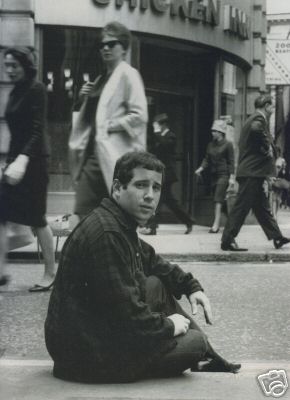 Paul in England
Paul in England 
In 1964 Paul moved to England , being attracted to the social and music scene of the Old Continent. He would later often describe the years spent in England as the happiest years of his life. Here he wrote new songs, made new recordings, and performed gigs in folk clubs to earn a living. It was in the folk scene that he met his English girlfriend Kathy Chitty, an enigmatic figure who would later find her way into songs such as ‘Kathy’s Song’, ‘Homeward Bound’ and ‘ America ’. Paul also performed in other European countries including France and Denmark . In 1965 he recorded his first solo album, The Paul Simon Songbook. With the valuable help of Judith Pieppe, a social worker who were among the first people to recognise Paul’s unique talents, several songs from the solo album were featured on the ‘Five to Ten’ program on BBC Radio. This proved to be an important break for Paul, as significant numbers of requests for his songs were made and as his solo music reached a wide audience for the first time.
Simon and Garfunkel
Meanwhile back at home in the United States , ‘The Sound of Silence’ was also beginning to gain popular appeal and was frequently requested on local radio stations. Recognising a unique opportunity, the producer Tom Wilson asked Paul’s permission to overdub the original folk record with an electric rock sound – consisting of an electric twelve-string guitar, bass and drums. The session players were the same as those working with Dylan on his album Highway 61 Revisited. Though he initially treated the new version with indifference, Paul soon found to his surprise that it brought the song even greater success. He would later recall that it was in Denmark before playing a folk gig that he found out the song had leapt from #101 to #59 on the Billboard charts, and from that moment on he knew that his life would be forever changed. By December 1965 ‘The Sound of Silence’ had risen to #1. Paul immediately returned to the US to make new recordings of old songs from the Wednesday Morning 3am album, in the same style as the folk-rock ‘The Sound of Silence’. Thus began the highlights of his Simon and Garfunkel career. The resultant album Sounds of Silence reached #23 on the charts, followed by Parsley, Sage, Rosemary and Thyme (1966), The Graduate (1967), Bookends (1968) and Bridge over Troubled Water (1970), all enormous critical and commercial successes. During this period the duo were awarded numerous Grammies, including 7 Grammies for Bridge over Troubled Water alone.
More detailed information about the ‘Simon and Garfunkel’ period of Paul’s career can be found here
Early Solo Career
After the split of Simon and Garfunkel in 1971, Paul began to write and record
solo material. His first album was the self-entitled Paul Simon released in
1972  . It went platinum reaching #4 on the US charts and #1 in the UK .
The flavour of the music was remarkably different from that of his folk rock
S&G days. Much of the music was inspired by Jamaican ska and reggae which
he had recently discovered. Notable songs from the album include ‘Mother
and Child Reunion’ (recorded in Kingston , Jamaica ), ‘Duncan’,
and ‘Me and Julio Down by the Schoolyard’.
. It went platinum reaching #4 on the US charts and #1 in the UK .
The flavour of the music was remarkably different from that of his folk rock
S&G days. Much of the music was inspired by Jamaican ska and reggae which
he had recently discovered. Notable songs from the album include ‘Mother
and Child Reunion’ (recorded in Kingston , Jamaica ), ‘Duncan’,
and ‘Me and Julio Down by the Schoolyard’.
Following rapidly in the wake of the first album came the light-hearted There
Goes Rhymin’ Simon in 1973  . The album was a great success, reaching #1 on the US charts and #4 in
the UK . There were also three hit singles from the album, ‘Kodachrome’
( US #1), ‘Loves Me like a Rock’ (US #3) and ‘Take Me
to the Mardi Gras’ ( US #8). Other popular songs from the album include
‘American Tune’ and ‘Something So Right’. During this
period Paul collaborated with gospel groups including The Dixie Hummingbirds
(featured on ‘Loves Me like a Rock’ and The Jessy Dixon Singers
who toured with Paul in 1974, from which resulted the concert album Live Rhymin’.
. The album was a great success, reaching #1 on the US charts and #4 in
the UK . There were also three hit singles from the album, ‘Kodachrome’
( US #1), ‘Loves Me like a Rock’ (US #3) and ‘Take Me
to the Mardi Gras’ ( US #8). Other popular songs from the album include
‘American Tune’ and ‘Something So Right’. During this
period Paul collaborated with gospel groups including The Dixie Hummingbirds
(featured on ‘Loves Me like a Rock’ and The Jessy Dixon Singers
who toured with Paul in 1974, from which resulted the concert album Live Rhymin’.
The third solo studio album Still Crazy After All These Years  was awarded the Grammy for Album of the Year in 1975. The single ’50
Ways to Leave Your Lover’ reached #1 in the US , and the
title track ‘Still Crazy After All These Years’, #5. The album
also contained Paul’s first collaboration with Artie post-S&G, on
the song ‘My Little Town’. Some of the music from the album was
written on piano rather than guitar, as Paul had developed calcium deposits
in his left hand during this period. The album itself is more rueful and at
times melancholic in flavour than its predecessors.
was awarded the Grammy for Album of the Year in 1975. The single ’50
Ways to Leave Your Lover’ reached #1 in the US , and the
title track ‘Still Crazy After All These Years’, #5. The album
also contained Paul’s first collaboration with Artie post-S&G, on
the song ‘My Little Town’. Some of the music from the album was
written on piano rather than guitar, as Paul had developed calcium deposits
in his left hand during this period. The album itself is more rueful and at
times melancholic in flavour than its predecessors.
Following these three albums came a lull in commercial success for Paul.
Although the albums One Trick Pony  and Hearts and Bones are adored by many fans, they did not enjoy the same
degree of public popularity. One Trick Pony was released in 1980, as the soundtrack
to a film of the same title, for which Paul wrote the screenplay and also
starred in as the main actor. The story is that of a struggling musician,
Jonah Levin, and the personal and professional obstacles in his life. The
film was not a success. However, the single ‘Late in the Evening’
from the album did reach #7 on the US charts.
and Hearts and Bones are adored by many fans, they did not enjoy the same
degree of public popularity. One Trick Pony was released in 1980, as the soundtrack
to a film of the same title, for which Paul wrote the screenplay and also
starred in as the main actor. The story is that of a struggling musician,
Jonah Levin, and the personal and professional obstacles in his life. The
film was not a success. However, the single ‘Late in the Evening’
from the album did reach #7 on the US charts.
The next album Hearts and Bones was released in 1983  .
It is considered by many fans to be Paul’s most underrated album. The
story behind its creation is complex, as it was originally intended to be
a Simon and Garfunkel collaboration. The duo had reunited for a free concert
in Central Park in 1981, for which an official CD and video recording were
released. Following the immense success of the evening, they went on tour
between 1982 and 1984 and had commenced recording together for a new album.
However, conflict eventually came between the pair again and the album remained
a solo work. Remarkable tracks from this album (although they remain unknown
to much of the public) include ‘Hearts and Bones’, ‘Train in
the Distance’ and ‘The Late Great Johnny Ace’.
.
It is considered by many fans to be Paul’s most underrated album. The
story behind its creation is complex, as it was originally intended to be
a Simon and Garfunkel collaboration. The duo had reunited for a free concert
in Central Park in 1981, for which an official CD and video recording were
released. Following the immense success of the evening, they went on tour
between 1982 and 1984 and had commenced recording together for a new album.
However, conflict eventually came between the pair again and the album remained
a solo work. Remarkable tracks from this album (although they remain unknown
to much of the public) include ‘Hearts and Bones’, ‘Train in
the Distance’ and ‘The Late Great Johnny Ace’.
During the period between Still Crazy After All These Year and Hearts and Bones, Paul also worked on a number of other projects including songwriting for the movie Shampoo, acting in the Woody Allen film Annie Hall, and making various comic appearances on Saturday Night Live. A Greatest Hits album was also released in 1977.
World Music: Graceland & The Rhythm of the Saints
The next period of Paul’s career would transform his status as a musician
as well as the realm of popular music. Following the commercial failure of
Hearts and Bones, Paul travelled to South Africa , intrigued by an instrumental
track ‘Gumboots’ by the Boyoyo Boys. He first heard the sound on
a tape given to him by his musical acquaintance Heidi Berg. In South Africa
he met and worked with local musicians and became immersed in the street music
of Soweto known as mbaqanga or ‘township jive’. He began recording
in Johannesburg and eventually emerged with the album Graceland in 1986
 . The album was buoyant and evocative, featuring a revolutionary fusion of
American and South African musical forms. Many South African musicians featured
on the album including Miriam Makeba, Hugh Masekala and Ladysmith Black Mambazo.
Considered to be one of the pioneering examples of world music, it was an
immense commercial success and won widespread critical acclaim. The album
reached #1 on the UK and on the US charts, and featured hit singles such
as ‘Boy in the Bubble’, ‘ Graceland ’ and ‘Homeless’.
It was also awarded the Grammy for Album of the Year in 1986 and the title
track was awarded Record of the Year in 1987. However, the release of
Graceland was also surrounded by controversy. Paul was blacklisted by the
United Nations and the African National Congress for breaching the anti-apartheid
boycott by recording in South Africa . Fortunately, his intentions of helping
the indigenous population soon became clear, and he was removed from both
blacklists in early 1987. An African tour soon followed along with the issue
of a live recording: Graceland (The African Concert) .
. The album was buoyant and evocative, featuring a revolutionary fusion of
American and South African musical forms. Many South African musicians featured
on the album including Miriam Makeba, Hugh Masekala and Ladysmith Black Mambazo.
Considered to be one of the pioneering examples of world music, it was an
immense commercial success and won widespread critical acclaim. The album
reached #1 on the UK and on the US charts, and featured hit singles such
as ‘Boy in the Bubble’, ‘ Graceland ’ and ‘Homeless’.
It was also awarded the Grammy for Album of the Year in 1986 and the title
track was awarded Record of the Year in 1987. However, the release of
Graceland was also surrounded by controversy. Paul was blacklisted by the
United Nations and the African National Congress for breaching the anti-apartheid
boycott by recording in South Africa . Fortunately, his intentions of helping
the indigenous population soon became clear, and he was removed from both
blacklists in early 1987. An African tour soon followed along with the issue
of a live recording: Graceland (The African Concert) .
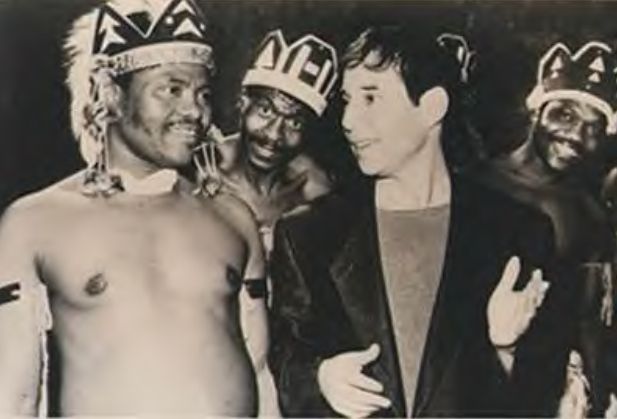
Paul further expanded his international vision with the release of The Rhythm
of the Saints in 1990  .
Featuring another display of innovative musical experimentation, the project
was inspired by and featured the sounds of Brazilian percussion and West African
guitar. The indigenous music was seamlessly fused with American blues and
jazz and the album reached #4 in the US charts and #1 in the UK . Paul
launched an extensive world tour entitled ‘Born in the Right Time’,
culminating in a free public performance in Central Park in August 1991, which
drew crowds of an estimated 500,000 people. A CD and video recording of the
event Concert in the Park was released.
.
Featuring another display of innovative musical experimentation, the project
was inspired by and featured the sounds of Brazilian percussion and West African
guitar. The indigenous music was seamlessly fused with American blues and
jazz and the album reached #4 in the US charts and #1 in the UK . Paul
launched an extensive world tour entitled ‘Born in the Right Time’,
culminating in a free public performance in Central Park in August 1991, which
drew crowds of an estimated 500,000 people. A CD and video recording of the
event Concert in the Park was released.

The Capeman
A long hiatus followed in Paul’s popular music career. Instead, he turned
his attentions to musicals, working on a project which he had conceived for
many years, exploring the story of an infamous Hispanic American Salvador
Agron, convicted of a gangland double murder in the 1950s in New York . Paul
collaborated with the Nobel-prize winning poet Derek Walcott on the production
entitled The Capeman, which opened on Broadway in January 1998. Perhaps due
to its controversial subject matter, the musical was a complete commercial
failure, closing after only two months of performances. It did however receive
some favourable critical reviews, including three Tony Award nominations.
A studio album Songs from the Capeman was released in late 1998  and the music has hence been celebrated in a series of concerts at the Brooklyn
Academy of Music in 2008.
and the music has hence been celebrated in a series of concerts at the Brooklyn
Academy of Music in 2008.
2000 and Beyond
Paul returned to the studio and emerged with the release of the album You’re
the One in 2000  .
Although it did not reach the commercial heights of previous albums, it was
still considered to be an artistic success, receiving a Grammy nomination
for Album of the Year.
.
Although it did not reach the commercial heights of previous albums, it was
still considered to be an artistic success, receiving a Grammy nomination
for Album of the Year.
Paul’s most recent studio release Surprise (2006)  also drew wide critical acclaim and reached #4 on the UK charts and #14
in the US . Innovative and fresh in its music and lyrics, it was co-produced
with Brian Eno, who was accredited for the ‘sonic landscapes’ of
the album.
also drew wide critical acclaim and reached #4 on the UK charts and #14
in the US . Innovative and fresh in its music and lyrics, it was co-produced
with Brian Eno, who was accredited for the ‘sonic landscapes’ of
the album.
Apart from his studio projects, Paul has been involved in various tours (including
a Simon and Garfunkel reunion tour in 2003), benefit and tribute concerts,
television appearances and charity work – notably with the Children’s
Health Fund, a mobile paediatric program which he cofounded with Dr Irwin
Redlener in 1987. A remastered box-set of his solo studio albums was released
in 2004, and a comprehensive record of his poetic lyrics was recently released
in the form of a book Lyrics: 1964 – 2008  .
Following his most recent European tour of 2008 he is continuing work in the
studio for a possible new album. The track ‘Love in Hard Times’
has already been performed live on several occasions (First time : Montreux
july 2008 ).
.
Following his most recent European tour of 2008 he is continuing work in the
studio for a possible new album. The track ‘Love in Hard Times’
has already been performed live on several occasions (First time : Montreux
july 2008 ).
Awards and Honours
As a contemporary singer-songwriter of arguably unparalleled versatility and talent, Paul has been the recipient of many awards and honours throughout his career. Most notably, he is 12-time Grammy winner, and has been inducted twice into the Rock ‘n’ Roll Hall of Fame (in 1990 as part of Simon and Garfunkel, and in 2001 as a solo artist). He received the prestigious Kennedy Centre Honours (America’s highest award to performing artists) in 2005, and his song ‘Father and Daughter’ written for the animation The Wild Thornberrys Movie was nominated for an Oscar for Best Original Song for a Motion Picture in 2006. In 2007, he received a Grammy Lifetime Achievement Award, and in the same year he became the inaugural recipient of the Library of Congress Gershwin Prize for Popular Song. His music, spanning four decades of innovation and creativity, was celebrated through a month-long series of retrospective concerts at the Brooklyn Academy of Music in 2008.
Personal Life
Spouse
Edie Brickell (30 May 1992 - present) 3 children
Carrie Fisher (16 August 1983 - July 1984) (divorced)
Peggy Harper (1969 - 1975) (divorced) 1 child
Although intensely private, Paul’s personal life is the oblique subject matter of much of his music. His first marriage was to Peggy Harper between 1969 and 1975. Their son Harper James was born in 1972. Paul’s second marriage was to Carrie Fisher from 1983 to 1984.
 Paul Simon & Carrie Fisher
Paul Simon & Carrie Fisher
However the pair had a tumultuous decade long relationship preceding and following the marriage. In 1992, Paul married singer-songwriter Edie Brickell. The couple have three children, Adrian Edward (1992), Lucia Jean (1995) and Gabriel Elijah (1998) and currently reside in New Canaan , Connecticut .
 Paul
& Eddie Brickel
Paul
& Eddie Brickel


